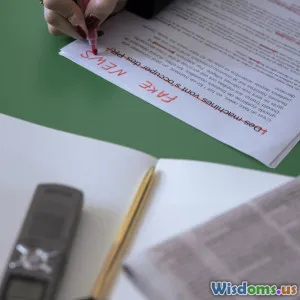
What Educators Miss When Teaching Problem Solving Techniques
9 min read Discover overlooked aspects in teaching problem-solving techniques and enhance educational practices for real-world success. (0 Reviews)
What Educators Miss When Teaching Problem Solving Techniques
Introduction
Problem-solving is often heralded as a cornerstone skill for academic achievement and lifelong success. From math classrooms to corporate training, educators around the globe focus on teaching systematic approaches to overcome challenges. Yet, despite widespread emphasis, many learners struggle to apply these techniques effectively in real-world contexts. Why? Because something critical is missing in the way problem-solving skills are taught.
This article aims to unravel what educators frequently overlook when instructing problem-solving methods, shedding light on the nuances crucial for cultivating true problem solvers. We will explore cognitive, emotional, and contextual factors that tend to fall outside formal curricula, providing deeper understanding and practical suggestions to enhance educational impact.
The Current Landscape: A Focus on Technique Over Thinking
Emphasis on Procedural Methods
Traditional instruction in problem solving often centers around formulaic processes and rigid frameworks. Take, for example, teaching students the "IDEAL" problem-solving model—Identify, Define, Explore, Act, Look back—widely used because it offers a clear sequence. Similarly, math problems typically come with well-defined parameters encouraging students to memorize steps rather than deeply understand the question.
While procedural knowledge is undoubtedly important—it provides scaffolding for novices—this approaches assumes problems are well-structured and lends little room for adaptability or creativity. According to a 2017 study published by the Journal of Educational Psychology, students proficient at mechanical procedures often floundered when given open-ended or ill-defined problems, pointing to a critical gap.
Lack of Focus on Metacognition and Mindset
Problem solving extends beyond following instructions; it requires metacognitive awareness—thinking about one’s thinking—and a growth-oriented mindset. Yet, educators frequently underemphasize teaching these aspects. Carol Dweck’s research on mindset reveals that individuals who perceive challenge as an opportunity to learn outperform those who view it as a threat.
However, most classrooms do not explicitly teach students to regulate their emotions, reflect on failure, or appreciate ambiguity. Without fostering resilience and flexibility, students may apply taught techniques superficially without building underlying confidence or self-regulation critical for overcoming complex problems.
Overlooked Dimensions in Problem-Solving Instruction
1. The Role of Context and Real-World Application
A major missing piece is providing authentic, context-rich problems that reflect the messy nature of real life. Many exercises are decontextualized simulations—essentially puzzles—with clear answers. A paper from the National Academy of Sciences highlights that students struggle to transfer learned techniques to novel scenarios as classroom exercises rarely mimic real-life complexity.
Example: In math education, a word problem about sharing apples sounds straightforward in a classroom, but solving a community transportation issue involves unknowable variables and constraints that can’t be easily systematized. When educators embed problem-solving in genuine social, scientific, or workplace contexts, learners develop practical sense and critical thinking.
2. Encouraging Collaborative Problem Solving and Diverse Perspectives
Problem solving is rarely done in isolation. Interpersonal dynamics, diverse viewpoints, and communication critically influence solutions. Yet, instruction often ignores collaborative strategies or fails to highlight cognitive diversity benefits.
Businesses like Google champion diverse teams because they recognize that heterogeneous perspectives produce better innovations. Incorporating cooperative problem-solving tasks where students must negotiate differing ideas and build consensus mimics these real-world conditions and enhances critical social skills.
3. Integrating Emotional Intelligence and Failure Management
The emotional landscape of encountering a difficult problem is profound. Anxiety, frustration, and self-doubt permeate the process. Traditional teaching frequently buffs out these messy emotional realities, promoting an impression that problems can be neatly and quickly solved.
However, resilience and emotional regulation are vital parts of problem-solving prowess. Angela Duckworth’s concept of “grit” stresses persistence despite setbacks; teaching students to embrace failure as feedback and recalibrate promotes a healthier, realistic approach.
Strategies to Bridge the Gap
Reorient from Steps to Strategies
Instead of rigid adherence to step-by-step templates, educators should teach adaptable problem-solving heuristics: brainstorming, analogy use, decomposition, and hypothesis testing. Emphasizing why to use certain strategies and when to switch fosters flexible thinking.
Embed Metacognitive Reflection
Regularly prompting students to articulate their thought process, decisions, and emotional responses can increase metacognition. Journaling or peer discussions about problem-solving experiences build self-awareness and critical reflection.
Promote Real-World, Open-Ended Problems
Curriculum designers and teachers should seek or design problems that lack a single correct answer and emulate authentic complexity. For instance, environmental projects requiring consideration of societal trade-offs invite learners to navigate uncertainty and conflicting priorities.
Facilitate Group Problem-Solving Exercises
Incorporating collaborative challenges with diverse participant groups develops communication skills, negotiation, and integrative thinking. Clear roles and use of digital collaboration tools can simulate modern workplace problem-solving.
Normalizing and Leveraging Failure
Educators must normalize mistakes and failures as integral to learning. Sharing historical examples—such as Thomas Edison’s iterative lightbulb experiments, where thousands of attempts were discarded—can inspire perseverance.
Real-World Insights
Case Study: Finland’s Phenomenon-Based Learning
Finland’s school system has shifted toward phenomenon-based learning, which involves students investigating broad, real-world themes through multiple disciplines. This holistic approach demands active problem solving in context. Reports indicate that students develop stronger critical thinking, creativity, and teamwork abilities, demonstrating concrete benefits of immersive problem solving beyond conventional techniques.
Corporate Training Programs
Companies like IBM and IDEO employ design thinking workshops emphasizing empathy, ideation, prototyping, and iteration. By simulating real challenges and incorporating user feedback, trainees build dynamic problem-solving capacity, illustrating that authentic environments and emotional involvement optimize learning.
Conclusion
Educators meticulously teach problem-solving techniques, yet often omit essential ingredients that transform routine exercises into powerful learning experiences capable of preparing students for real, unpredictable challenges. The missing pieces include focusing beyond procedural fluency to foster metacognition, resilience, emotional awareness, collaboration, and contextual understanding.
Addressing these gaps requires intentional shifts: broadening problem types, emphasizing mindset development, and incorporating authentic, collaborative experiences. In doing so, educators can ignite curiosity, equip learners with adaptable tools, and empower them to confidently navigate complex problems in academics and life.
The future demands not only problem-solvers but problem appreciators—those who embrace uncertainty, think critically, and collaborate creatively. By rethinking how we teach problem solving, education can evolve from knowledge transmission to true cognitive transformation.
“The formulation of the problem is often more essential than its solution.” – Albert Einstein
Let this guide spark your next step in elevating problem-solving education that truly matters.
Rate the Post
User Reviews
Popular Posts

















